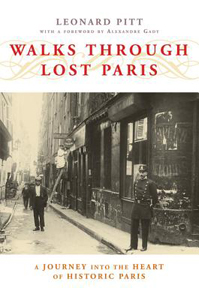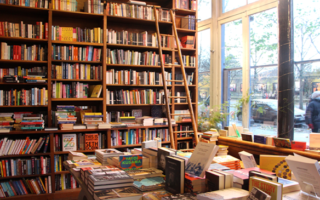Book Review: Walks Through Lost Paris

- SUBSCRIBE
- ALREADY SUBSCRIBED?
BECOME A BONJOUR PARIS MEMBER
Gain full access to our collection of over 5,000 articles and bring the City of Light into your life. Just 60 USD per year.
Find out why you should become a member here.
Sign in
Fill in your credentials below.
 There are more books written about Paris than anyone can wade through in a lifetime – and for those of us who stroll the streets of Paris with some regularity and familiarity, most of them feel repetitive and unneccessary. The only Paris guidebook I usually take with me is one of the three volumes of historian Thirza Vallois’ Around and About Paris, because Vallois is unique- including not only a comprehensive street by street guide to the entire city but also in depth insights into the Paris of both today and yesterday along with numerous historical tidbits.
There are more books written about Paris than anyone can wade through in a lifetime – and for those of us who stroll the streets of Paris with some regularity and familiarity, most of them feel repetitive and unneccessary. The only Paris guidebook I usually take with me is one of the three volumes of historian Thirza Vallois’ Around and About Paris, because Vallois is unique- including not only a comprehensive street by street guide to the entire city but also in depth insights into the Paris of both today and yesterday along with numerous historical tidbits.
Therefore, I was surprised and excited when quite by accident I recently discovered another book to carry with me – one that covers much less of Paris than Thirza’s works, but covers it in a very different way – Leonard Pitt’s Walks Through Lost Paris.
Pitt’s book, which includes only four “walks’ – in the fourth, fifth and sixth arrondissements – brings to life with clarity, through the use of detailed text along with numerous maps, diagrams, and historic and modern photos, the changes Baron Haussman wrought when between 1853 and 1870 Napolean III ordered him to clean up and rebuild the rabbit warren of streets that was then Paris, and the continuing damages wrought later by others.
Pitt notes Haussman demolished over 20,000 buildings and many streets-wiping out entire neighborhoods, and built 45,000 new structures plus boulevards such as Boulevard St. Germaine. He decries also the smaller scale but equally devastating demolitions after Haussman. For example, Haussman’s desire to do away with medeival Ile de La Cite was completed by others in the 1900s – leaving scant remnants around rues Massilon and Chanoinesse (see pp. 66 & 67)
Pitt writes with immense love and understanding of historic Paris, and indicts the modern urban planner for continuing to wreak historical havoc building by building.
Follow the text and walks and peruse the sometimes color-coded photos and maps and old postcards to see vividly what once existed under or behind what exists today, and how bloodless structures replace more charming architecture.
Pitt studied mime in Paris in the 1960s, living in what he romantically thought to be a historic neighborhood – to discover years later that the buildings had been barely 90 years old. He returned to Paris to search archives and walk the streets to discover the magnitude of what had changed, and as he researched and collected photos he felt a desire to “get a bucket of paint with a large brush and paint lines on the streets and sidewalks to mark out where the old city ran so everyone could see.”
He did much the same thing by writing this book.
See pages 60-61 where Pitt describes the controversy surrounding Haussman’s demolition of most of the structures around Notre Dame, including two photos taken from the top of Notre Dame – one of the neighborhood in 1855, thick with houses and other structures, and another in 1865 showing most of the structures demolished.
Look at the photos of the Cour de Commerce St. Andre (pages 42-43) which once continued south to Rue de l’Ecole de Medicine, and the photo of a 19th century rue de l”Ecole de Medicine on page 34 highlighting in blue the old entrance to the Cour not needed once Haussman lopped off the south half of the Cour de Commerce to make way for Blvd. St. Germain. Note the Phillipe-Auguste wall and towers guarding the area in a 1615 drawing and 12th century map on page 43 – the one tower remaining today colored blue in the drawing and marked with a red dot on the map – and the 1958 photo of that tower in the interior of a blacksmith shop on the Cour de Commerce.
The Paris I love and revisit is the Paris of narrow stone streets, buildings exuding antiquity, medeival churches, and cafes palpable with the aura of writers and artists of yore. Leonard Pitt, thinking he sensed that past around his tiny Avenue de L’Opera garret, was moved into action when he later found out how wrong he had been. Walks Through Lost Paris, published in 2006, is the fascinating result.
More in book, France book, Paris book reviews, Paris books


